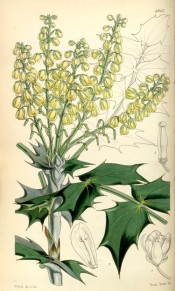Mahonia bealei Carr.
A large shrub with 5-9 pairs of leaflets and racemes, to 15cm long, of pale yellow flowers in winter. Has been sold as Mahonia japonica, which it somewhat resembles. [RHSD, Hortus, Hilliers’].
Horticultural & Botanical History
This plant was figured in Curtis’s Botanical Magazine as Berberis bealei Fort. at BM t.4852/1855, and B. bealii var. planifolia at BM t.4846/1855. It was found by Robert Fortune in China and introduced to Britain c.1845.
‘Fortune discovered the now figured, as related in the Gardeners’ Chronicle, above quoted, in China, about 150 miles north of China, in the district of Hwuy-Chow. “The shrub was about eight feet high, much branched, and far surpassing in beauty all the known species of Mahonia.” “Sir William Hooker,” he continues, “informs me that this may be the plant which Thunberg calls Ilex Japonica, figured and described by Thunberg” (which Mr. Brown had long ago properly referred to Berberis), and I think so still, and Dr. Lindley has expressed the same opinion very confidently; while, on the other hand, Mr. Don, in his Flora of Nepaul, and Drs. Hooker and Thomson, in their printed, but yet unpublished, Flora Indica, have unhesitatingly, without having seen authentic specimens, referred Thunberg’s plant to B. Nepalensis, Wall.; a species with very long leaves, bearing numerous pairs of leaflets, of a narrower form, more membranaceous texture (I am comparing our Chinese plant, for Thunberg’s figure is very unsatisfactory), narrower and less pungent leaves, strongly veined. On referring to Mr. Bentham’s Herbarium however, we find a Japan specimen (leaf only), gathered by Siebold in Japan, and this is clearly identical with known B. Nepalensis! and we certainly do find in some of our Indian specimens, here and there, leaves which exhibit the varied forms of leaflets, the same rigid coriaceous texture, and very pungent spines seen in all our states of J. [sic] Bealei. There is no reason whatever for retaining the name of Japonica, in this instance so long buried and lost as it were in the genus Ilex; and, though a further acquaintance with the Japan and Chinese Berberries may show our Bealei to be a distinct species, the probability is that it will be found to merge into the well-known B. Nepalensis. I may here observe, too, that Messrs. Standish and Noble have sent me, from their Bagshot Nursery, another sort of Berberis from China, akin to the present, having longer leaves, concave on their upper surface, and more approaching B. Nepalensis: in no way, I think, really distinct from B. Bealei, all highly ornamental, and, horticulturally speaking, different from each other.’ [BM t.4852/1855].
History at Camden Park
Listed only in the 1857 catalogue [T.151/1857].
Notes
A less likely possibility is Mahonia japonica (Thunb.) DC., synonym Berberis japonica R.Br., from China.
An erect evergreen shrub with stout, upright branches and up to 19 sharply-toothed leaflets per leaf. Arching, then spreading racemes of fragrant, pale yellow flowers from autumn to spring are followed by blue-purple berries. To 2m. Long cultivated in Japan. Mahonia japonica has often been distributed as Mahonia bealei. [RHSD, Hortus, Hilliers’].
Berberis japonica Miq. = Berberis macrophylla Hort. Ex Lindl. which see.
Published Feb 24, 2010 - 03:44 PM | Last updated Jul 14, 2010 - 05:13 PM
| Family | Berberidaceae |
|---|---|
| Category | |
| Region of origin | China |
| Synonyms |
|
| Common Name | |
| Name in the Camden Park Record |
Berberis japonica |
| Confidence level | medium |


